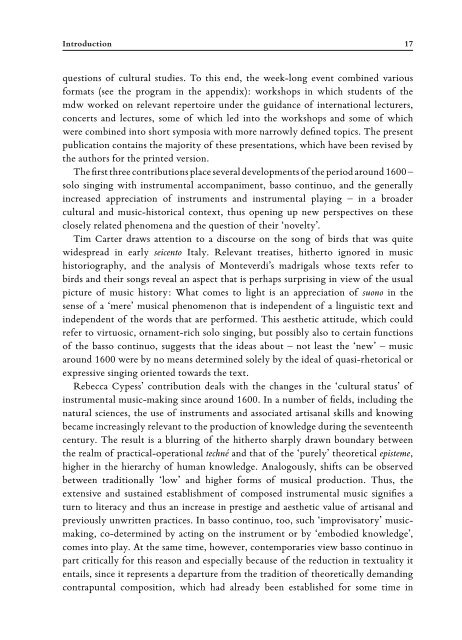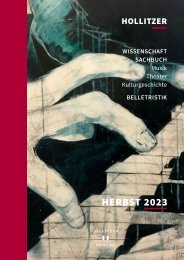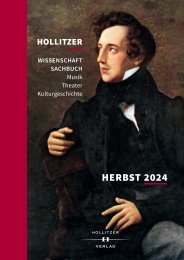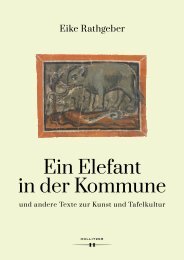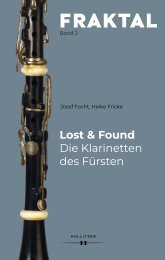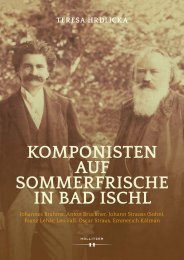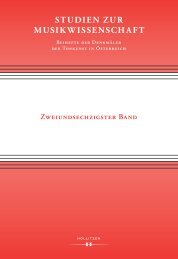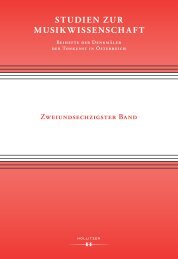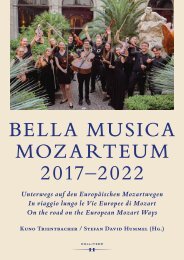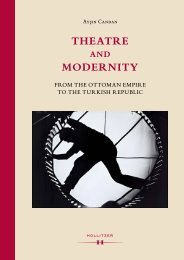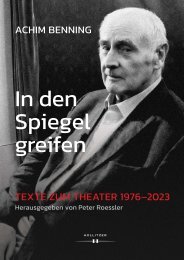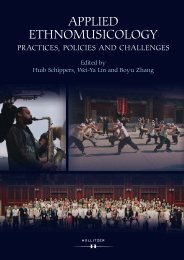Leseprobe_Anklaenge 2020-2021
Erfolgreiche ePaper selbst erstellen
Machen Sie aus Ihren PDF Publikationen ein blätterbares Flipbook mit unserer einzigartigen Google optimierten e-Paper Software.
Introduction<br />
17<br />
questions of cultural studies. To this end, the week-long event combined various<br />
formats (see the program in the appendix): workshops in which students of the<br />
mdw worked on relevant repertoire under the guidance of international lecturers,<br />
concerts and lectures, some of which led into the workshops and some of which<br />
were combined into short symposia with more narrowly defined topics. The present<br />
publication contains the majority of these presentations, which have been revised by<br />
the authors for the printed version.<br />
The first three contributions place several developments of the period around 1600 –<br />
solo singing with instrumental accompaniment, basso continuo, and the generally<br />
increased appreciation of instruments and instrumental playing – in a broader<br />
cultural and music-historical context, thus opening up new perspectives on these<br />
closely related phenomena and the question of their ‘novelty’.<br />
Tim Carter draws attention to a discourse on the song of birds that was quite<br />
widespread in early seicento Italy. Relevant treatises, hitherto ignored in music<br />
historiography, and the analysis of Monteverdi’s madrigals whose texts refer to<br />
birds and their songs reveal an aspect that is perhaps surprising in view of the usual<br />
picture of music history: What comes to light is an appreciation of suono in the<br />
sense of a ‘mere’ musical phenomenon that is independent of a linguistic text and<br />
independent of the words that are performed. This aesthetic attitude, which could<br />
refer to virtuosic, ornament-rich solo singing, but possibly also to certain functions<br />
of the basso continuo, suggests that the ideas about – not least the ‘new’ – music<br />
around 1600 were by no means determined solely by the ideal of quasi-rhetorical or<br />
expressive singing oriented towards the text.<br />
Rebecca Cypess’ contribution deals with the changes in the ‘cultural status’ of<br />
instrumental music-making since around 1600. In a number of fields, including the<br />
natural sciences, the use of instruments and associated artisanal skills and knowing<br />
became increasingly relevant to the production of knowledge during the seventeenth<br />
century. The result is a blurring of the hitherto sharply drawn boundary between<br />
the realm of practical-operational techné and that of the ‘purely’ theoretical episteme,<br />
higher in the hierarchy of human knowledge. Analogously, shifts can be observed<br />
between traditionally ‘low’ and higher forms of musical production. Thus, the<br />
extensive and sustained establishment of composed instrumental music signifies a<br />
turn to literacy and thus an increase in prestige and aesthetic value of artisanal and<br />
previously unwritten practices. In basso continuo, too, such ‘improvisatory’ musicmaking,<br />
co-determined by acting on the instrument or by ‘embodied knowledge’,<br />
comes into play. At the same time, however, contemporaries view basso continuo in<br />
part critically for this reason and especially because of the reduction in textuality it<br />
entails, since it represents a departure from the tradition of theoretically demanding<br />
contrapuntal composition, which had already been established for some time in


